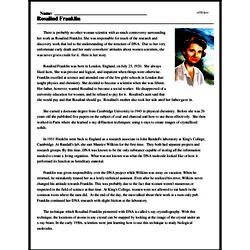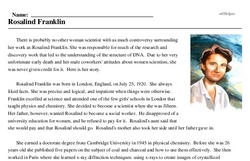Rosalind Franklin
Rosalind Franklin
Reading Comprehension for July 25
There is probably no other woman scientist with as much controversy surrounding her work as Rosalind Franklin. She was responsible for much of the research and discovery work that led to the understanding of the structure of DNA. Due to her very unfortunate early death and her male coworkers' attitudes about women scientists, she was never given credit for it. Here is her story.
Rosalind Franklin was born in London, England, on July 25, 1920. She always liked facts. She was precise and logical, and impatient when things were otherwise. Franklin excelled at science and attended one of the few girls' schools in London that taught physics and chemistry. She decided to become a scientist when she was fifteen. Her father, however, wanted Rosalind to become a social worker. He disapproved of a university education for women, and he refused to pay for it. Rosalind's aunt said that she would pay and that Rosalind should go. Rosalind's mother also took her side until her father gave in.
She earned a doctorate degree from Cambridge University in 1945 in physical chemistry. Before she was 26 years old she published five papers on the subject of coal and charcoal and how to use them effectively. She then worked in Paris where she learned x-ray diffraction techniques: using x-rays to create images of crystallized solids.
In 1951 Franklin went back to England as a research associate in John Randall's laboratory at King's College, Cambridge. At Randall's lab, she met Maurice Wilkins for the first time. They both had separate projects and research groups. By this time, DNA was known to be the only substance capable of storing all the information needed to create a living organism. What was not known was what the DNA molecule looked like or how it performed its function as hereditary material.
Franklin was given responsibility over the DNA project while Wilkins was away on vacation. When he returned, he mistakenly treated her as a lowly technical assistant. Even after he realized his error, Wilkins never changed his attitude towards Franklin. This was probably due to the fact that women weren't numerous or respected in the field of science at that time. At King's College, women were not allowed to eat lunch in the common room where the men did. At the end of the day, the men talked about their work at a men-only pub. Franklin continued her DNA research with slight friction at the laboratory.




